
Stirlingia simplex is a plant endemic to Western Australia.
Muellerolimon salicorniaceum, the sole species in genus Muellerolimon, is a succulent perennial herb or shrub that grows on salt mudflats in Western Australia.

Trichodesma zeylanicum, commonly known as Northern bluebell, camel bush or cattle bush, is a herb or shrub native to Australia.

Asteridea is a genus of flowering plants in the family Asteraceae. Evidence suggests that the genus, Asteridea, is monophyletic.
Trochocarpa clarkei, commonly known as lilac berry, is a rare flowering plant in the family Ericaceae. It is endemic to sub-alpine areas of Victoria in Australia. It is a shrub which grows to around 30 cm high. The flowers are maroon with a greenish base. The fruits, which appear in autumn, are about 8 mm in diameter. These are eaten by small mammals and birds. The species occurs in subalpine areas of the southern highlands, often in association with Eucalyptus pauciflora.
Wendlandia psychotrioides is a species of shrubs or small trees, constituting part of the plant family Rubiaceae.
Hollandaea is a small genus of plants in the family Proteaceae containing four species of Australian rainforest trees. All four species are endemic to restricted areas of the Wet Tropics of northeast Queensland.
Grevillea pterosperma, commonly known as desert grevillea or desert spider-flower, is a flowering plant species in the family Proteaceae, endemic to Australia.
Hollandaea sayeriana, sometimes named Sayer's silky oak, is a small species of Australian rainforest trees in the plant family Proteaceae.
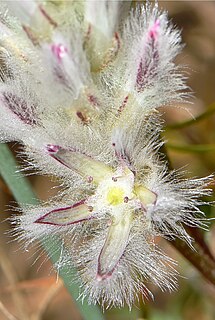
Ptilotus pyramidatus, the pyramid mulla mulla, is a small white herb in the family Amaranthaceae.

Ptilotus schwartzii is a grass-like plant in the Amaranthaceae family.

Asteridea chaetopoda is a species of herb in the Asteraceae family, which is endemic to Western Australia, in the south-west. It was first described in 1876 as Athrixia chaetopoda by Ferdinand von Mueller, and allocated to the genus, Asteridea, in 1980 by G. Kroner. It is a perennial herb, growing on sandy soils, on limestone and on gypsum, to heights from 5 cm to 30 cm. Its yellow flowers may seen from August to November on salt lakes, stony rises, and dunes of Beard's Eremaean and South-West Provinces.
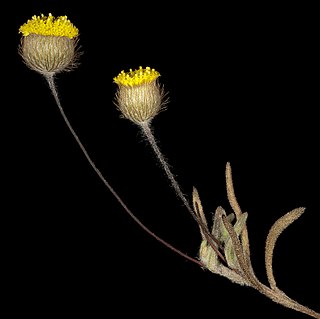
Asteridea athrixioides is a herb in the Asteraceae family, which is endemic to Australia, and found in Western Australia, South Australia and Victoria. It was first described in 1853 by Otto Sonder and Ferdinand von Mueller as Panaetia athrixioides, who described it from specimen(s) collected in the Port Lincoln district. In 1980, G. Kroner assigned it to the genus, Asteridea, giving it the name Asteridea athrixioides. It is an annual herb, growing on calcareous, sandy or clay soils to heights of from 5 cm to 20 cm. Its yellow flowers may seen from July to November on saline on allvial flats, rocky hills and undulating plains.
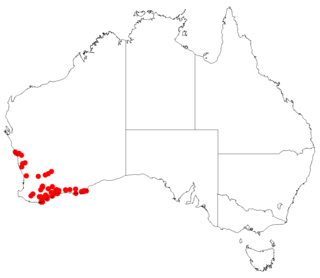
Asteridea asteroides is a herb in the Asteraceae family, which is endemic to Western Australia. It was first described in 1853 by Nikolai Turczaninow as Trichostegia asteroides. In 1980, G. Kroner assigned it to the genus, Asteridea, giving it the name Asteridea asteroides. It is a perennial herb, growing on sand or gravelly sand to heights of from 5 cm to 30 cm. Its white flowers may seen from August to November in Beard's South-West Province.
Asteridea archeri is a herb in the family Asteraceae, which is endemic to Western Australia. It was first described in 2000 by Philip Short. It is found growing on gypsum dunes in salt lakes to heights from 20 cm to 1 m. Its white flowers may seen from September to October in Beard's Eremaean Province. There are no synonyms.

Asteridea morawana is a herb in the Asteraceae family, which is endemic to Western Australia. It was first described in 2000 by Philip Short.
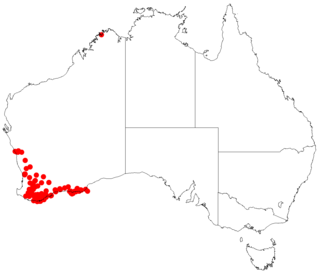
Asteridea nivea is a herb in the Asteraceae family, which is endemic to Western Australia. It was first described in 1845 by Joachim Steetz as Chrysodiscus niveus. In 1980, G. Kroner assigned it to the genus, Asteridea, giving it the name Asteridea nivea. It is a perennial herb, sometimes erect, sometimes low-spreading which grows on sandy soils often over granite, laterite, or limestone to heights from 10 cm to 60 cm, in rock crevices, on ridges and coastal cliffs. Its white to white-pink flowers may seen from April to May or August to September in Beard's South-West Province, that is, the IBRA regions of Avon Wheatbelt, Esperance Plains, Geraldton Sandplains, Jarrah Forest, Mallee, and Warren.

Ptilotus humilis is an annual herb in the Amaranthaceae family, native to Western Australia. It was first described as Trichinium humile by Nees von Esenbeck in 1845 but was transferred to the genus, Ptilotus, by Ferdinand von Mueller in 1868.
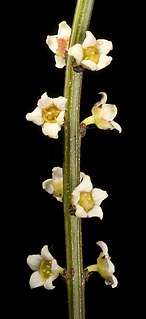
Psammomoya choretroides is a small shrub in the Celastraceae family, endemic to the south west of Western Australia. It was first described by Ferdinand von Mueller in 1889 as Logania choretroides, but was transferred to the genus, Psammomoya, in 1904 by Ludwig Diels and Ludwig Eduard Theodor Loesener.

Rhodanthe battii is a plant in the Asteraceae family, native to Western Australia.













